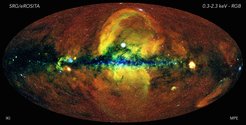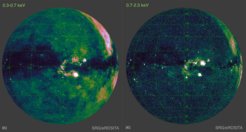A million sources and the Milky Way on the X-ray map of the entire sky
eROSITA telescope aboard SRG observatory completed its first all-sky survey

A map of the whole sky, built by astrophysicists of the two scientific consortia of SRG/eRosita in Germany and Russia is shown in the figure. Each consortium created their images for one half of the sky. These images were so beautiful, that both consortia decided to stitch two halves in the Aitoff projection and show a joint map, which turns out to be the best all-sky map in the history of X-Ray astronomy!
The jointly created map is so a called “X-ray RGB map” where photons of different energies are shown in different colours – from 300 to 600 eV in red, from 600 eV to 1.0 keV in green and from 1 to 2.3 keV in blue. The colours on this map, obtained from about 400 million photons registered by eRosita during the past six months, allow one to immediately judge the temperature of radiating gas, ranging from 3 to more than 10 million Kelvin.
At the very center of the map a supermassive black hole SGR A* is located with a mass of about 4 million solar masses. It is a rather weak X-ray source nearly invisible on this map. At the middle plane of the picture lies the disk of our Milky Way, which we can observe in its full glory with a naked eye on a dark summer night. However, on the X-ray map, the Milky Way looks like a dark band because the molecular gas and dust in the plane of the Galaxy absorb X-rays. The blue dots located in this region reveal the presence of a large number of bright and powerful X-ray sources in the Milky Way – X-ray pulsars, accreting black holes and neutron stars in binary stellar systems, remnants of supernova explosions.
The good angular resolution and high sensitivity of the eROSITA telescope allowed it to map over a million of compact sources and tens of thousands of extended sources. Such a large number of sources cannot be demonstrated in a single image, with only the brightest of them being visible on the map as dots. The first sky survey by the Spectrum-RG satellite allowed the eROSITA telescope to construct a map containing almost 10 times more sources and about four times more sensitive than the former world-best map of the German satellite ROSAT, obtained in 1990. In just six months of scanning the sky, eROSITA was able to double the total number of sources recorded by all satellites in the world over 60 years of X-ray astronomy. “This all-sky image completely changes the way we look at the energetic universe,” says Peter Predehl, the Principal Investigator of eRosita at the Max-Planck Institute for Extraterrestrial Physics (MPE). “We see such a wealth of detail – the beauty of the images is really stunning”.
This map allows one to see how hundreds of supernova explosions, and possibly the activity, from time to time, of the supermassive black hole in the center of our Galaxy, which has lead to the giant bubbles of hot gas with temperatures up to 10 million degrees expelled from the plane of our Galaxy (bright zones above and below the midplane of the image). Some two hundred thousand fairly close stars with coronae much more powerful than that of our Sun also contribute to the emission of zones with a lower temperature.
About three quarters of the objects on this map are distant quasars and active galactic nuclei nuclei powered by accretion (infall) of matter onto supermassive black holes residing in their centers. They are far beyond the Milky Way at distances of hundreds of millions and billions of light years from us. Among the objects on this map, quasars with redshifts of more than 6 are already found. We also see on the map about 20 thousand extended clusters of galaxies filled with mysterious "dark matter". It will take years to accurately measure the redshifts of the quasars and clusters of galaxies discovered by eROSITA. “But now we can begin to use these objects located at gigantic distances for purpose of cosmology, to find out when such objects began to grow in the Universe and to estimate the properties of the Universe as a whole,” says Rashid Sunyaev, PI of the SRG observatory in Russia.

The SRG/eRosita maps of the hemisphere analyzed by the Russian eROSITA consortium in the 0.3-0.7 and 0.7-2.3 keV energy bands.
The telescopes of the SRG Observatory continue to operate. Now, SRG begins its second survey of the sky, which is expected to last until the end of the year. In total, during the next three and half years it is planned to obtain seven more such all-sky maps. The final map will be about 5 times more sensitive than the first, and the number of sources on it should increase by about 5-8 times. “We believe that then we can be confident that maps and source catalogs obtained by SRG will be used by astrophysicists and cosmologists of all countries of the world for decades to come, until scientists and leading space agencies decide that it is time to create an even more sensitive X-ray sky map”, notes Rashid Sunyaev.
The SRG spacecraft was designed by Lavochkin Association, Roskosmos corporation and launched on July 13, 2019 with a Proton launcher from Baikonur cosmodrome. The SRG observatory was built with participation of DLR, Germany in the framework of Russian Federal Space Program by the initiative of the Russian Academy of Sciences represented by its Space Research Institute (IKI). The observatory carries two unique X-ray grazing incidence telescopes: ART-XC (IKI, Russia) and eROSITA (MPE, Germany). The SRG/eROSITA telescope was built under the leadership of Max-Planck-Institute for Extraterrestrial Physics (MPE) and DLR. The SRG spacecraft is operated by Lavochkin Association and Deep Space Network Antennae in Bear Lakes, Ussurijsk and Baykonur funded by Roskosmos.













